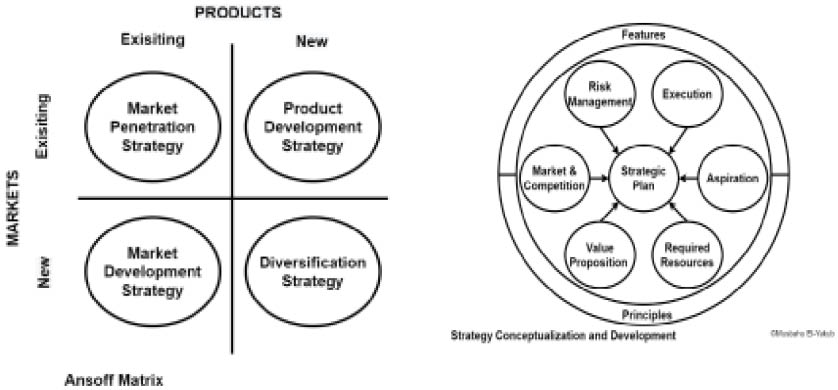In the course of this series so far, we clarified what a few terms that are often confused with strategy really mean and also defined exactly what strategy in business is. We also introduced the features of a great strategy and the principles of strategy development. Today, we will discuss strategy frameworks and the process of strategy conceptualisation and development.
Strategy frameworks: A framework is defined as an essential supporting structure that underlies a concept or system. A framework could also be a set of rules or ideas that can be used to deal with issues. From the perspectives of the study and development of strategy, frameworks have evolved as challenges of business administration changed over time. The initial challenges in the early part of the twentieth century were about corporate structure as was captured in Alfred Sloan’s book ‘My Years With General Motors’ and even more specifically by Alfred Chandler’s ‘Strategy and Structure’. The challenges of running large, multi-product firms morphed into the need for shaping the ‘strategic intent’ and developing and protecting the ‘core competencies’ of a business.
Consequently, there have been several strategic frameworks developed to address strategy conceptualisation challenges at various times. These include the GE-Mckinsey Nine-Box Matrix, the BCG Growth-Share Matrix, the Balanced Scorecard, etc. A simple, functional, and timeless framework is the Ansoff Matrix. Also called the Product-Market Matrix, is used to identify, plan, and evaluate strategies. The Ansoff Matrix brings out at least four possible strategies that you will need to develop depending on what your goal is. For instance, you will need to develop a ‘market penetration’ strategy if you want to achieve growth through existing product in an existing market. On the other hand, you will need to develop a ‘diversification strategy’ if you will be introducing a new product in a new market. The schematic for the Ansoff Matrix is shown below. The schematic for the Ansoff Matrix is shown below.
Regardless of the type of strategy you will need to pursue, you will have to develop its components from ‘ground up’ based on the process we will be discussing below.
Developing strategy: Whatever is your stage and state of business, operating environment and strategic goal, mission and vision, you will need to develop an operating strategy. We have mentioned the features of great strategies as well as the principles on which strategies should be built. These should be kept in mind at all times in the conceptualisation and development process. The typical questions that you will need to ask, think about deeply and answer honestly and in detail revolve around the schematic shown below:
* What is your aspiration? I like to think of aspiration as one of two (joint) starting points (the other being your value proposition, below) in strategy conceptualisation and development. You must have a goal you passionately desire to achieve before you can begin to consider the other issues. But beyond the goal, which have to be clear and articulate, you will also need to have a vision. Your goal and vision are what set you ‘on a mission’, unleashing all intellectual, physical and emotional energies you will need. In addition, articulating your goal, having a vision and being on a mission, makes you focus your effort and channel your resources on your endeavour committedly. Without an aspiration that you are passionate to and committed to, achieving not much is probably the best you can do.
Your aspirations should include both your personal dreams about, and the specific business goals that you will plan to achieve over a set period. For practical purposes, they are broken into short-term and long-term goals. Similarly, they can be broken into high-level corporate goals and lower functional unit objectives. Regardless of the level and the time frame, they should be ‘SMART’ as in Specific, Measurable, Achievable, Realistic and Time-bound.
What is your value proposition? Unfortunately, many people go into business ‘just to make money’. I would say those are mere opportunists, definitely not entrepreneurs. Entrepreneurs identify where they can provide value to a group of people that are willing to pay for it, and then make money out of the process. If you begin, as an entrepreneur, with a value proposition and you get it right, the money follow.
Your value proposition is the raison d’être of why potential customers will be attracted to your business and why they should trust and patronise you consistently. Without a clear and customer-focussed value proposition, even otherwise excellent products will fail in the market. You value proposition is basically the benefits, tangible and intangible, that your customers stand to gain from patronising you. Often, your value proposition is under constant threat from competitors who can provide the same or better benefits than you. But as far as developing strategy is concerned, what is important is that you have to be clear about the value you offer and ensuring that you will provide value that your competitors are unable to offer or at the least, you provide the same value but better or somehow differently. There are different sources of value such as price, product quality, customer service, etc. Whatever it may be, you will need to be consistent, protect it, and always seek to improve it ahead of the competitors behind you or by your side.
Today, we have introduced what strategy frameworks are and how they began to formally evolve some one hundred years ago. We have also begun to introduce the questions to ask and answer in developing strategy. We will conclude the series next week by taking up more questions to be answered.

 Join Daily Trust WhatsApp Community For Quick Access To News and Happenings Around You.
Join Daily Trust WhatsApp Community For Quick Access To News and Happenings Around You.

